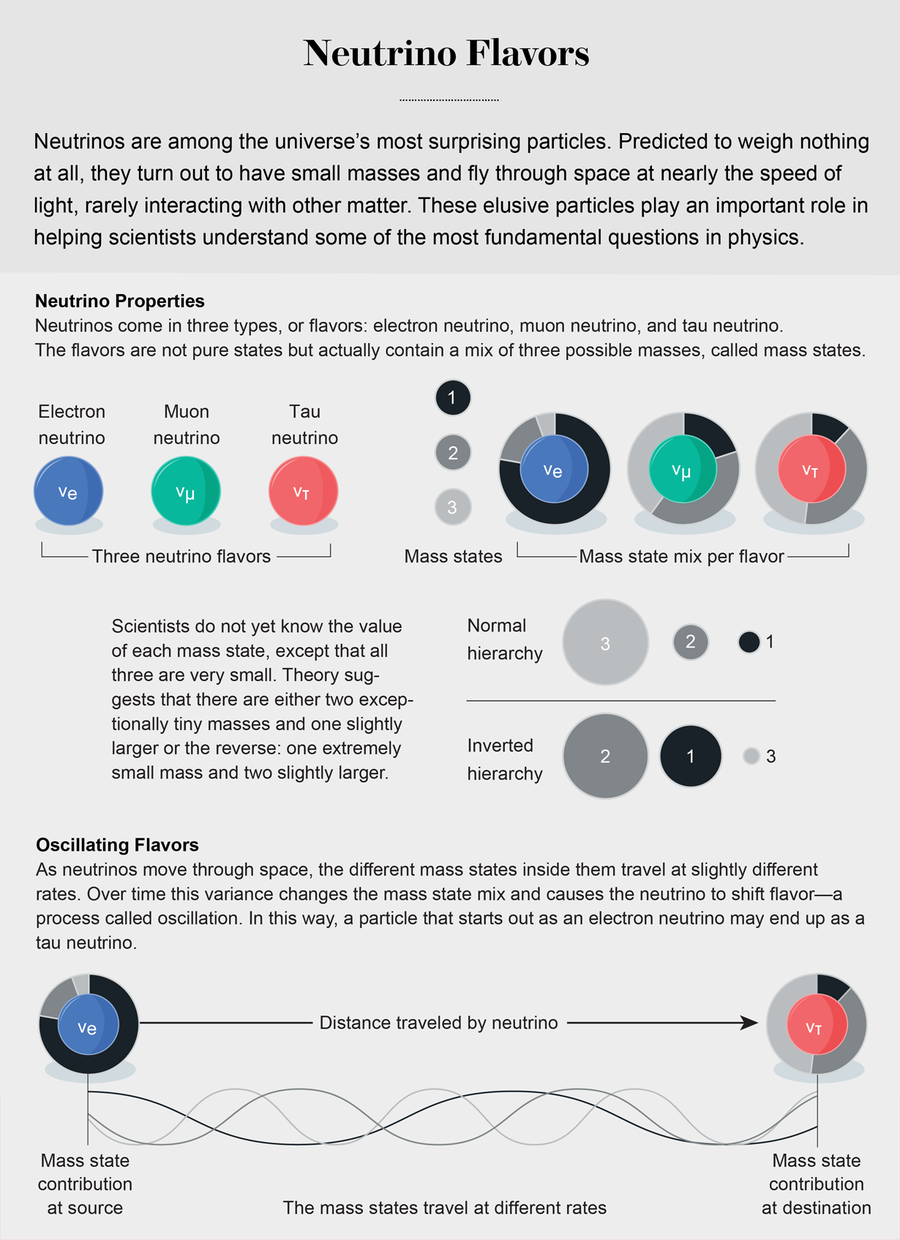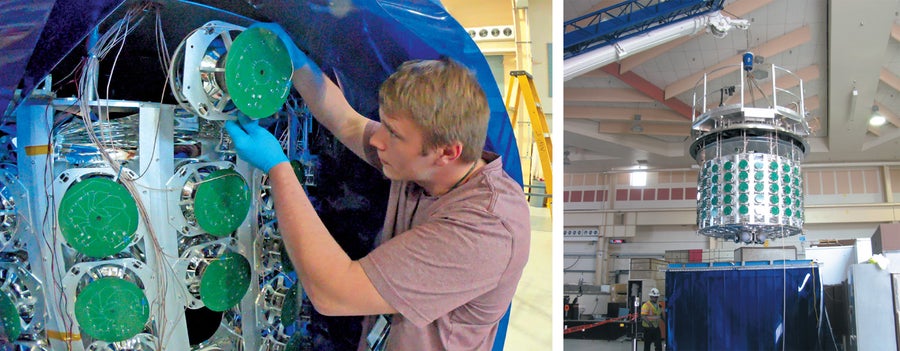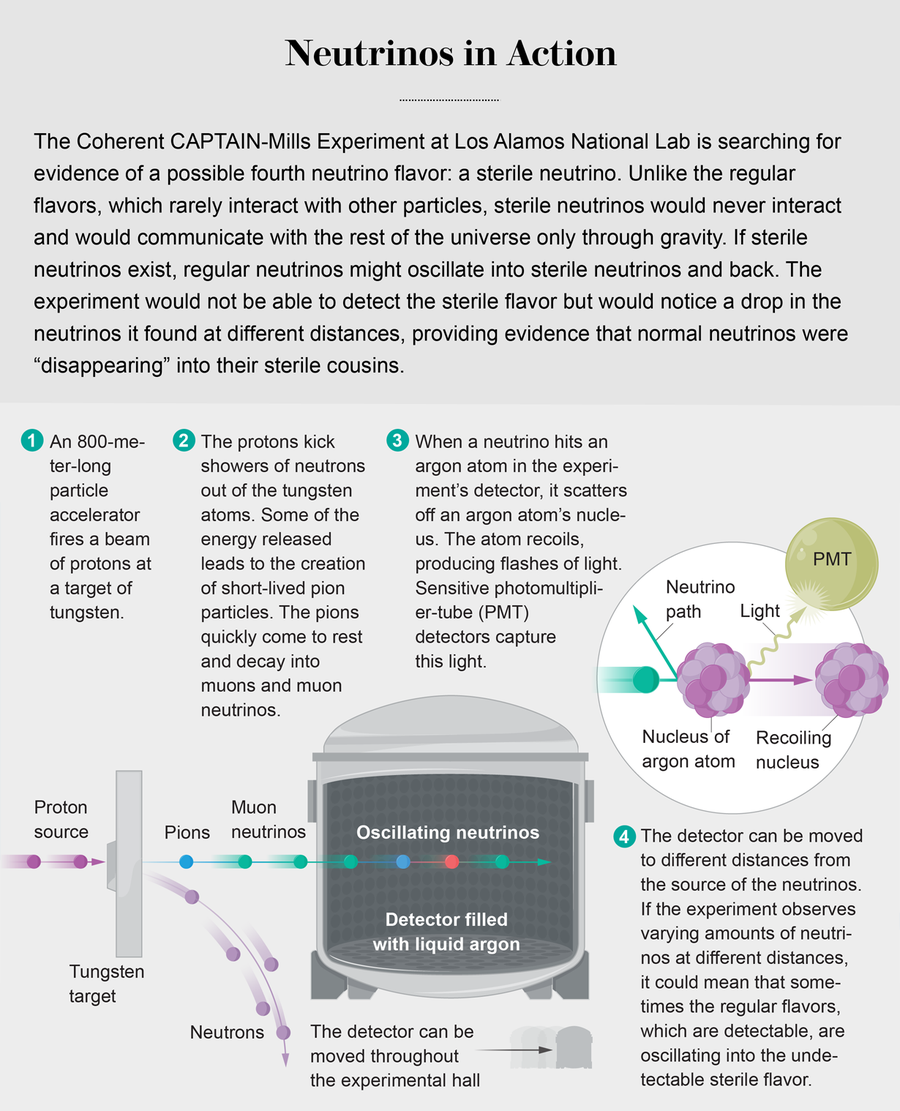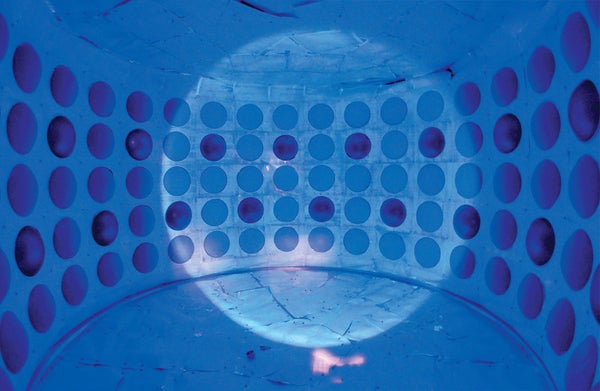The physicists who came to our presentation at the 2010 Neutrino conference in Athens, Greece, probably expected us to put to rest a controversial finding from a decade prior. Instead we left them in a stunned silence.
The story begins in 1996, when we revealed data, obtained at the Liquid Scintillator Neutrino Detector (LSND) at Los Alamos National Laboratory, suggesting a problem with the widely accepted idea that neutrinos—tiny, ubiquitous particles that pass right through most matter—come in three types, or flavors. Our results showed that there might be a fourth neutrino flavor that had gone undetected. The scientific community was skeptical, and in fact, early data from a follow-up experiment hinted that our 1996 results were off—there was no fourth neutrino flavor after all. That day in Athens it was clear that the audience expected our latest findings to shut the door on the LSND results once and for all. We revealed, however, that the evidence for a fourth type of neutrino had become even more compelling.
We had not discovered the particle, but our work, conducted as part of the Mini Booster Neutrino Experiment (MiniBooNE) at Fermi National Accelerator Laboratory in Batavia, Ill., showed that there was almost certainly a problem with the contemporary understanding of particle physics. The most likely solution was a new neutrino—a “sterile” neutrino, so called because it would not interact with other matter in any way except through gravity. In the decade since our presentation in Greece, data from MiniBooNE have bolstered the case for a fourth flavor of neutrino even further.
On supporting science journalism
If you're enjoying this article, consider supporting our award-winning journalism by subscribing. By purchasing a subscription you are helping to ensure the future of impactful stories about the discoveries and ideas shaping our world today.
We now think there is more than a 99.999999 percent chance that something is going on beyond the scope of known physics, and sterile neutrinos are a strong contender. The idea that our experiments might be detecting a fourth neutrino remains controversial, however, because the Standard Model of particle physics is one of the most tested and thoroughly confirmed theoretical frameworks in history—and it allows for only three neutrinos. Nevertheless, we know the Standard Model is not complete, because it cannot explain dark matter or dark energy, the invisible stuff that seems to dominate the cosmos. And a new neutrino flavor might just be a link to that hidden realm. Finally, after years of uncertainty, several projects are beginning around the world—including our own Coherent CAPTAIN-Mills (CCM) experiment—that could put this mystery to bed.
What Is a Sterile Neutrino?
All neutrinos are ghostly. Trillions of them fly through you every second at nearly the speed of light. Yet a sterile neutrino would be the ghostliest of them all. Because it does not experience the strong, weak and electromagnetic forces through which other particles interact, it would be essentially undetectable. This quality would render it part of the invisible realm physicists call the dark sector, which includes the dark energy and dark matter that make up 95 percent of the energy density of the universe. Sterile neutrinos may be able to interact with dark matter through new forces of nature. They might even be dark matter: some hypotheses suggest that sterile neutrinos make up some or even most of the invisible matter in the cosmos.
If sterile neutrinos exist, it will be the latest in a series of surprises this puzzling family of particles has thrown at physicists. The first came in the 1960s, when experiments designed to catch the neutrinos flying toward us from the sun measured far fewer than scientists expected. All stars are fueled by nuclear fusion reactions in which protons combine to form helium nuclei, which in turn fuse to create heavier elements. Among the products of these reactions are electron neutrinos—one of the three known flavors, along with muon and tau neutrinos. Theory predicted that a steady stream of the particles from the sun would make their way to observatories on Earth, yet experiments measured only a small fraction of the anticipated number. The resulting deficit was known as the solar neutrino problem.

Credit: Lucy Reading-Ikkanda
Many physicists initially assumed that we just did not really understand how the sun works. The real issue turned out to be both simpler and a lot more problematic. It was not that the sun emitted fewer neutrinos than expected. It was that the neutrinos were not making it to our terrestrial detectors—or rather they were changing en route.
What scientists eventually figured out is that a neutrino is not a pure object. Rather every neutrino consists of a mix of all neutrino types and can oscillate through the various flavors as it travels. This discovery was surprising for a variety of reasons. For starters, the fact that neutrinos can change their flavor means they cannot be massless particles traveling at light speed, as the Standard Model predicted. The reason is a consequence of Einstein's special theory of relativity, which tells us that time moves more slowly for an object in motion than for a stationary one. As an object's speed increases, time continues to slow until it actually stops. That is the point when the object reaches the speed of light—meaning that if you could travel at light speed, time would seem to stand still, with the whole universe frozen in place. If neutrinos alter their flavor, though, they must undergo change and therefore experience time. Thus, they must be traveling more slowly than light, which means they cannot be massless. Particles moving at the speed of light would have no mass, according to relativity, so if they are slower than that, they must have some mass—and the Standard Model has a problem. This revelation, and the discovery that neutrinos oscillate, won Takaaki Kajita and Arthur B. McDonald the 2015 Nobel Prize in Physics.
Surprising Signals
The unexpected ability of neutrinos to switch flavors is what we and others were studying back in the 1990s and 2000s at LSND and MiniBooNE, when we kept finding hints of extra neutrinos. Both experiments were attached to particle accelerators that created steady streams of muon neutrinos, and both used detectors placed some distance away that were tuned to observe electron neutrinos.
If you could sail along beside a single neutrino as it traveled through space, you would see it oscillate from one type to another, cycling through all the flavors. The electron, muon and tau flavors would all be observable, at least in principle. If sterile neutrinos exist, however, neutrinos could also transform into this fourth flavor. To a flying-along observer, the particle would simply seem to disappear for this segment of its flight. In the simplest case, the neutrino would reappear some time later as one of the regular flavors (although there is a theoretical possibility that a sterile neutrino could decay, ending the oscillation cycle entirely).

COHERENT CAPTAIN-MILLS researcher T. J. Schaub lifts out a photomultiplier tube to be replaced as part of a neutrino detector upgrade (left). Workers raise the CCM neutrino detector out of its container, which is filled with liquid argon when the experiment is running (right). Credit: Los Alamos National Laboratory
Oscillations among the three normal neutrino flavors most often take place over long distances. Because sterile neutrinos are likely to be more massive than the regular flavors, however, particles could make the switch to this type more quickly and could likewise change back from sterile to one of the three regular flavors over shorter distances. Thus, if sterile neutrinos exist, they should speed the oscillation process and dramatically reduce the distance that a muon neutrino, for example, would travel before transforming into an electron neutrino.
That is exactly what we found in our earlier experiments: it seemed that muon neutrinos were disappearing much faster than we expected as they traveled from their sources, and electron neutrinos were turning up in numbers higher than anticipated. We observed oscillations over lengths of merely tens to hundreds of meters rather than the tens to hundreds of kilometers that we expected. Such high numbers of muon neutrinos should not have been able to switch into electron neutrinos over the distance of the experiments unless, perhaps, they were transforming into sterile neutrinos on the way.
Our experiments are not the only ones with anomalous results. Some neutrino detectors set up near nuclear reactors have also found hints of something amiss. Like the sun, nuclear reactors create neutrinos as a by-product, and several experiments have been carried out near them to study the particles. They have revealed fewer neutrinos than expected, which suggests that some of the particles may be oscillating into sterile neutrinos on their way from the reactors. These results are harder to interpret, however, because physicists do not know exactly how many neutrinos should be produced in fission reactors. Therefore, the lower-than-expected neutrino count could be the result of sterile neutrinos, or scientists might have simply overestimated how many particles they should find.
Physicists in Russia are avoiding these uncertainties with an experiment called DANSS (detector of the reactor antineutrino based on solid-state plastic scintillator). This project takes place underneath a nuclear reactor, but the scientists vary the distance between the reactor and the neutrino detector every few days to see whether the electron neutrinos are truly morphing into other flavors as they move away from their source. This approach may tell the researchers whether short-range oscillations are occurring even if they do not have precise estimates of the number of neutrinos produced in the reactor.
The enormous IceCube Neutrino Observatory in Antarctica is also searching for sterile neutrinos. This cubic-kilometer array of photodetectors buried in the polar ice records a light signal called Cherenkov radiation, created when a high-energy neutrino from the upper atmosphere interacts with ice and sets off a shower of particles. Studying the Cherenkov light collected in the photodetectors tells scientists about the type, energy and flight direction of the neutrino that sparked the particle shower.
The IceCube team will soon report an eight-year analysis of neutrinos passing through Earth to the IceCube array. The study will search for signs of muon neutrinos disappearing, which, if found, could imply the existence of sterile neutrinos consistent with the results from LSND and MiniBooNE.
All of the evidence for sterile neutrinos is intriguing and suggestive, but it is not yet conclusive. The neutrinos studied in IceCube come in a broad range of energies, which makes analyzing their oscillations complex. It is also difficult in reactor experiments to distinguish the neutrinos researchers seek from background neutrinos produced in the sun and from radioactive decays in common detector materials that can masquerade as signals.
In experiments such as those at LSND and MiniBooNE, the accelerators that produce the neutrinos can be turned on and off to determine the level of background noise. Even in those types of experiments, we have been limited in part by our inability to look for neutrinos at more than a small range of distances. Methods for catching neutrinos in the past typically have relied on large, immobile detectors that limit our flexibility. The projects are comparable to taking a frame from a single point in a movie, and what we need is a sequence of frames to get the whole story.
A Novel Strategy
A new breed of experiment now coming online should be able to capture the multiple frames we need. Ideally, as mentioned earlier, we would fly alongside a neutrino and watch it oscillate. We cannot do that, but these experiments give us a way of taking snapshots during the oscillation process that could reveal traces of sterile neutrinos if they exist. Such projects include the Short-Baseline Neutrino program at Fermilab and the CCM experiment that we are just beginning at Los Alamos.
CCM is housed in a hall in the Los Alamos Neutron Science Center (LANSCE) at the end of an 800-meter-long particle accelerator. The accelerator fires a beam of protons at a tungsten target. When the protons hit the tungsten, they kick showers of neutrons out of the target atoms through a process called neutron spallation. Some of the energy released during this process leads to the creation of short-lived pion particles. The pions quickly come to rest and decay into muons and, more important for our purposes, muon neutrinos with a very specific energy.

Credit: Lucy Reading-Ikkanda
CCM detects neutrinos through coherent neutrino scattering, an effect that relies on the fact that all particles (including neutrinos) act not just like little marbles but also like waves. This wave-particle duality is a cornerstone of quantum mechanics. The wavelength associated with a particle depends on the particle's energy. High-energy, fast-moving particles have short wavelengths, and slow-moving, low-energy particles have long wavelengths. When short-wavelength neutrinos strike an atomic nucleus, they interact with a single neutron or proton inside it. But something special happens when a neutrino's energy is low enough that its wavelength is comparable to the diameter of an atomic nucleus. Instead of striking a single proton or neutron in an atom, a low-energy neutrino interacts with the entire nucleus. It is somewhat analogous to waves passing a boat. A series of short ripples on water has hardly any effect on the motion of a large boat, but very long waves on the open ocean will lift that same boat dramatically. Because a long-wavelength neutrino interacts with an atomic nucleus as a whole instead of as a collection of small bits, the chances of the neutrino hitting the entire nucleus are much greater at low energies than at high energies.
Unlike high-energy neutrinos, a low-energy neutrino bounces off an atom's entire nucleus. This type of scattering is called “coherent” because the wavelength and the nucleus are similar in size. The atom recoils when it is hit. If the interaction takes place in a suitable material, the recoiling atom produces minute flashes of light, and the neutrino continues on its way, albeit in a different direction than it was heading in initially. By capturing the light flash with a sensitive photomultiplier-tube detector, we can determine when and where the neutrino scattered from the atom, as well as the atom's kinetic energy. Although coherent scattering cannot reveal an individual neutrino's flavor, it can measure the sum of all three known neutrino flavors across interactions. This fact is crucial: if the sum is not the expected number of neutrinos, unmeasured sterile neutrinos—which would not scatter off argon and therefore would not create any flash of light—may be involved.
Given that our chances of a neutrino hitting a whole atomic nucleus are higher than the chances of its hitting just one of its nucleons, we can use smaller detectors in such experiments than the gargantuan ones that have been necessary for many neutrino detectors in years past. In contrast to MiniBooNE's 800-metric-ton detector vat of mineral oil, the CCM detector contains 10 metric tons of liquid argon. And because the detector is compact, we can move it from place to place to observe neutrinos at a range of distances from their source. If neutrinos oscillate frequently enough over the tens of meters available in the LANSCE experimental hall, we will observe the total sum of neutrino interactions to vary by distance. Such an observation would be smoking gun evidence that oscillations into sterile neutrinos are occurring—because with only three flavors, we should see no oscillations at all over such small distances.
The possibility exists, of course, that CCM will find no evidence of sterile neutrinos. In that case, the observations of the known neutrinos would appear to decrease steadily as we moved the CCM detector farther from the tungsten target, much as the apparent brightness of a lightbulb decreases as you walk away from it.
Though disappointing, nondetection would not rule out the existence of one or more sterile neutrinos. It would, however, allow us to place limits on their potential properties. Because neutrino oscillations depend on the relative masses of neutrinos and a parameter known as the mixing angle, a failure to find signs of a sterile neutrino can give us a handle on what the relative masses and mixing angles are not likely to be, effectively narrowing the range of parameters that future searches for sterile neutrinos must consider.
Beyond the Standard Model
Experimentalists who offer results at odds with the Standard Model are appropriately deemed guilty until proven innocent because historically scientists who have challenged the Standard Model have been wrong. Nevertheless, it is certain that the Standard Model is not the entire story. Neutrino oscillations alone are proof of that fact.
Neutrino research has been a harbinger of exciting new developments in physics since the first neutrinos were discovered in 1956 by our Los Alamos predecessors Frederick Reines and Clyde Cowan. Although sterile neutrinos remain a controversial topic 25 years after we first found signs of them, experiments are now on the verge of resolving the controversy one way or the other.

